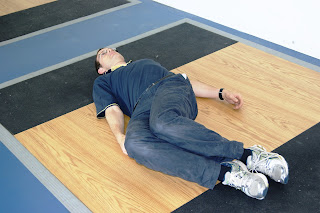What is lower limb node dissection?
Lower limb node dissection is
a surgical procedure that opens the pelvic area to identify, examine or remove
lymph nodes. Lymph nodes are small
glands that are part of the lymphatic system, and filter fluids. These nodes are normally removed in order to
determine the necessity of further treatment based on cancer cell spread.
Why do the exercises?
The aim of these exercises is
to regain normal leg movement after node surgery or radiotherapy in the pelvic
area. It is important to move the leg,
so the tissues around your hips don’t get tight and cause pain.
The exercises should always
be done slowly. You may feel some
discomfort but it should not be painful.
If you develop lasting pain for
30 minutes or more you might need to change the exercises by doing less of them
or doing them more gently.
If pain continues consult
your Exercise Physiologist or Nurse.
When do you start?
It is best to start these exercises
as soon as possible after surgery, so if possible aim to start the day after
your surgery. Always check with your Surgeon
that they are happy for you to start.
Week 1 Start with the Level 1 exercises
Week 2-4 Move
on to doing Level 1 and then Level 2 exercises
Week 4+ If you have full range of motion start with gentle
strength exercises
(Seek further advice about which exercises are
suitable)
Week 4+ If you have full range of motion start with gentle
strength exercises
(Seek further advice about which exercises are
suitable)
Perform the exercises in the
order shown below.
When do you need to seek further advice?
Before starting these
exercises check with your nurse or surgeon that they are happy for you to
start.
If you notice any excessive
oozing, redness or severe pain please stop the exercises and consult your
doctor or nurse as soon as possible.
If you are in doubt about the
exercises and how to do them, or if you feel you are ready to progress, you can
contact the CanMove programme for further advice or assistance.
How often should I do the exercises?
Start by running through them
twice a day and if you can aim for 3 times a day. Pick times of the day when it will be easy
for you to remember to do the exercises.
When you first wake, after lunch and before bed can be good times to get
in the habit of doing the exercises.
Always focus on having good
technique during the exercises so if you notice you are tiring during the
exercises and can’t do them properly it is better to have a break and try again
later. Little and often is better than
doing one long session.
Over time the exercises
should start to become easier. If you
notice you can regularly do an exercise fully you need to move on to one of the
more advanced exercises in this book or consult with a healthcare professional
to find the next step.
It is important to continually
progress exercises so you get stronger. Continue
to exercise even if symptoms or side effects have reduced.
If you have not regained full
range of motion within 3 weeks or would like further assistance please contact
your Nurse or Exercise Physiologist.
LEVEL 1
Legs elevated
Legs elevated
Before starting the exercises lie on your back with your
feet elevated.
Toe curls and
extension
Aim for 3 sets of 15 repetitions per day
Keeping your legs and ankles relaxed and elevated curl the
toes towards the sole of your foot then extend them back as far as you can.
Each foot can be done either together or one at a time.
Pointing Foot
Aim for 3 sets of 15 repetitions per day
Keeping your legs relaxed and elevated point your feet
keeping the toes extended then flex them back as far as you can. Repeat.
Ankle Circles
Aim for 3 sets of 15 repetitions per day
Keeping your legs relaxed and elevated move the feet in
clockwise circles trying to get the ankle working at its full range in every
direction.
Repeat anticlockwise.
Knee to chest
Aim for 3 sets of 15 repetitions per day. Hold for 5
seconds.
Keeping one leg elevated pull the other leg by the shin
towards your chest and hold.
LEVEL 2
Knee roll
Knee roll
Aim for 3 sets of 15 repetitions per day
Lie with both knees at 90 degrees and roll both knees to the
left and right slowly.
Keep the upper body still.
If you are comfortable you may lift the feet off the ground
with the knees at 90 degrees and roll them to either side.
Leg Raise
Aim for 3 sets of 15 repetitions per day.
Keeping one leg elevated brace your stomach muscles
and lift the other leg off, pause for a couple of seconds then lower it
gradually.
|
Leg extension
Aim for 3 sets of 15 repetitions per day
Raise alternate legs,
with knee bent at 90 degrees, one at a time while maintaining the contraction.
|
Side leg raise
Aim for 3 sets of 15 repetitions per day
Clench buttocks and raise top leg and return to
start without touching the top leg on the ground.
|
WEEK 4+
Once you have regained full
range of motion in your pelvic area and your wound has healed it is beneficial
to start some gentle strength exercises.
Strength exercises will help further improve and maintain function in
the area.












No comments:
Post a Comment